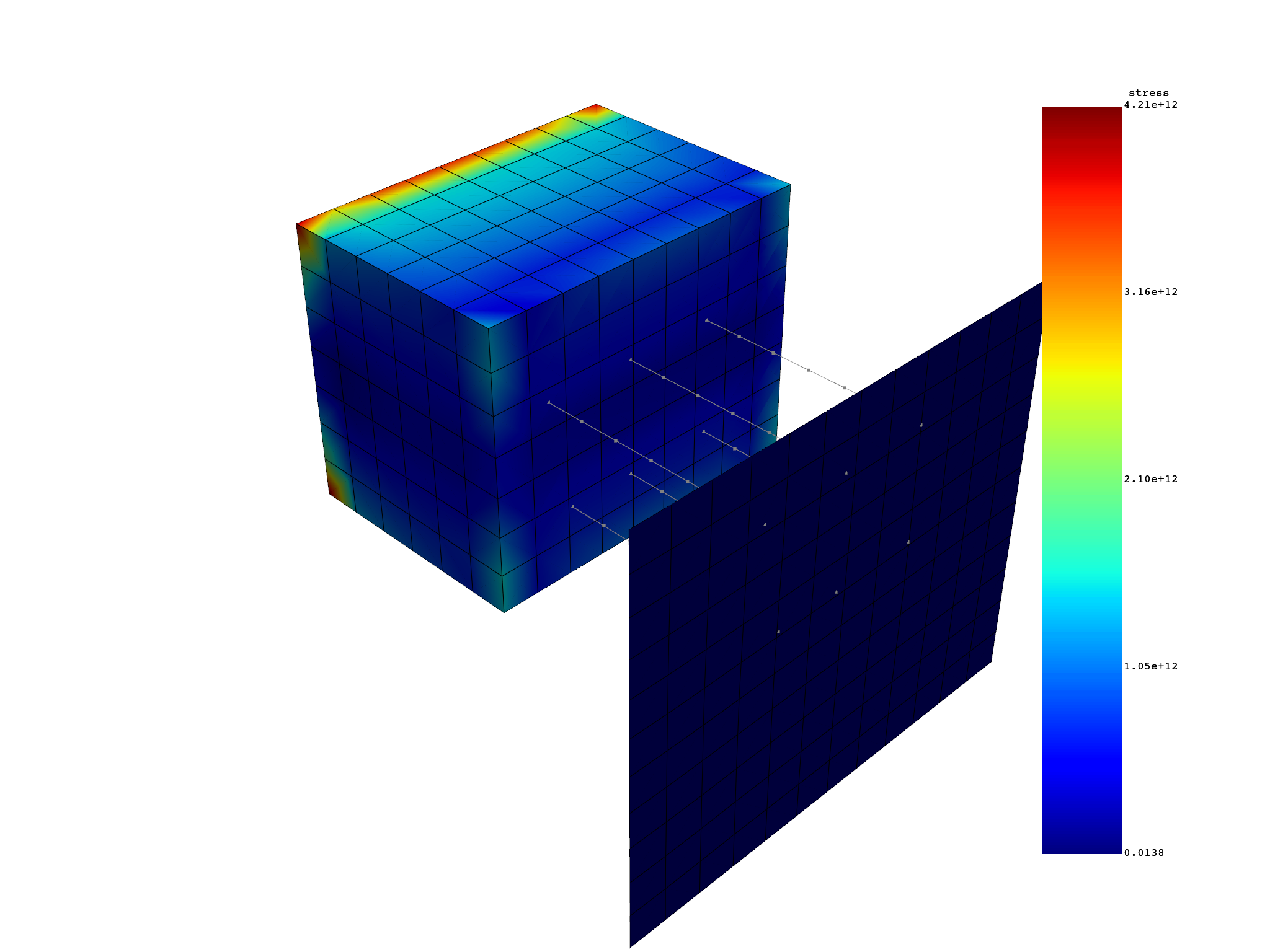Note
Go to the end to download the full example code.
Postprocess the result file for a modal analysis#
This example shows how to use the legacy PyDPF-Post API to postprocess the result file for a modal analysis.
Perform required imports#
Perform required imports. This example uses a supplied file that you can
get by importing the DPF examples package.
from ansys.dpf import post
from ansys.dpf.post import examples
Get Solution object#
Get the Solution object. This example loads a result file for a modal analysis
computed in Ansys Mechanical.
example_path = examples.download_all_kinds_of_complexity_modal()
solution = post.load_solution(example_path)
print(solution)
Modal Analysis Solution object.
Data Sources
------------------------------
DPF DataSources:
Result files:
result key: rst and path: /opt/hostedtoolcache/Python/3.10.19/x64/lib/python3.10/site-packages/ansys/dpf/core/examples/result_files/testing/modal_allKindOfComplexity.rst
Secondary files:
DPF Model
------------------------------
Modal analysis
Unit system: MKS: m, kg, N, s, V, A, degC
Physics Type: Mechanical
Available results:
- node_orientations: Nodal Node Euler Angles
- displacement: Nodal Displacement
- nodal_rotation: Nodal Rotation
- reaction_force: Nodal Force
- smisc: Elemental Elemental Summable Miscellaneous Data
- element_nodal_forces: ElementalNodal Element nodal Forces
- stress: ElementalNodal Stress
- elemental_volume: Elemental Volume
- stiffness_matrix_energy: Elemental Energy-stiffness matrix
- artificial_hourglass_energy: Elemental Hourglass Energy
- kinetic_energy: Elemental Kinetic Energy
- co_energy: Elemental co-energy
- incremental_energy: Elemental incremental energy
- thermal_dissipation_energy: Elemental thermal dissipation energy
- elastic_strain: ElementalNodal Strain
- elastic_strain_eqv: ElementalNodal Strain eqv
- element_orientations: ElementalNodal Element Euler Angles
- nmisc: Elemental Elemental Non Summable Miscellaneous Data
- structural_temperature: ElementalNodal Structural temperature
------------------------------
DPF Meshed Region:
2388 nodes
1836 elements
Unit: m
With solid (3D) elements, shell (2D) elements, shell (3D) elements, beam (1D) elements
------------------------------
DPF Time/Freq Support:
Number of sets: 45
Cumulative Frequency (Hz) LoadStep Substep
1 4800.665229 1 1
2 6472.119402 1 2
3 10094.813112 1 3
4 15408.070193 1 4
5 19935.616102 1 5
6 30659.224027 1 6
7 33485.028985 1 7
8 40514.020302 1 8
9 41144.836724 1 9
10 41696.364343 1 10
11 42568.142453 1 11
12 48803.935725 1 12
13 51557.014600 1 13
14 54829.807966 1 14
15 55121.065060 1 15
16 55481.661956 1 16
17 55779.054274 1 17
18 56346.453210 1 18
19 56598.396154 1 19
20 57504.056787 1 20
21 57768.209089 1 21
22 60135.893137 1 22
23 62336.016111 1 23
24 62809.029190 1 24
25 64186.171203 1 25
26 64911.479227 1 26
27 66488.724651 1 27
28 66728.182829 1 28
29 67521.333063 1 29
30 68699.230845 1 30
31 70108.268581 1 31
32 71432.124756 1 32
33 71784.765113 1 33
34 73189.275762 1 34
35 74862.553459 1 35
36 75051.318416 1 36
37 76335.025905 1 37
38 76631.728520 1 38
39 76956.786796 1 39
40 77754.144888 1 40
41 78460.122703 1 41
42 78721.878185 1 42
43 79330.520798 1 43
44 80301.992725 1 44
45 80835.840814 1 45
This may contain complex results.
Get Result objects#
Get displacement result#
The displacement result contains a field for real values and a field for imaginary values.
disp_result = solution.displacement()
disp = disp_result.vector
Get number of fields#
disp.num_fields
1
Get data from a field#
disp.get_data_at_field(0)
DPFArray([[-1.17102876, -1.30206342, -1.1938849 ],
[-1.69750554, -1.68258886, -0.76327262],
[-2.24465543, -2.66699745, -1.36365734],
...,
[ 0. , 0. , 0. ],
[ 0. , 0. , 0. ],
[ 0. , 0. , 0. ]], shape=(2352, 3))
Get maximum data value over all fields#
disp.max_data
DPFArray([[3.63870030e+05, 8.31378342e+20, 5.99358159e+21]])
Get minimum data value over all fields#
disp.min_data
DPFArray([[-3.55151557e+05, -8.31378342e+20, -5.99358159e+21]])
Get maximum data value over targeted field#
disp.get_max_data_at_field(0)
DPFArray([3.63870030e+05, 8.31378342e+20, 5.99358159e+21])
Get minimum data value over all fields#
disp.get_min_data_at_field(0)
DPFArray([-3.55151557e+05, -8.31378342e+20, -5.99358159e+21])
Get stress result#
Get a stress result that deals with amplitude. It contains a field for real values and a field for imaginary values.
stress_result = solution.stress()
Check if support has complex frequencies#
stress_result.has_complex_frequencies()
False
Get tensor result#
stress = stress_result.tensor
stress.num_fields
2
Get shell field#
shell_field = stress[0]
shell_field.shell_layers
<shell_layers.nonelayer: 5>
Get solid field#
solid_field = stress[1]
Plot amplitude contour#
amplitude = stress_result.tensor_amplitude
stress.plot_contour()

Get elastic strain result#
Get an elastic strain result that deals with phase. It contains a field for real values and a field for imaginary values.
elastic_strain_result = solution.elastic_strain()
elastic_strain = elastic_strain_result.tensor
# Get number of fields
# ~~~~~~~~~~~~~~~~~~~~~~
# Get the number of shell and solid elements in distinct fields.
elastic_strain.num_fields
2
If the result file contains results, use this method to get the elastic strain result.
print(solution.plastic_strain())
Complex tensor object.
Tensor object.
Object properties:
- location : Nodal
Complex plastic strain object.
Total running time of the script: (0 minutes 1.080 seconds)

